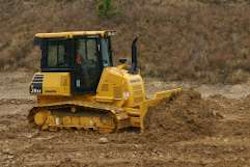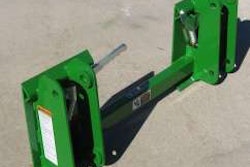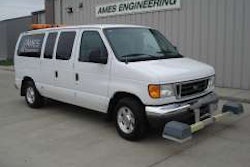Preserving the Unpaved Road
‘Gravel,’ stone-surfaced and dirt road preservation helped by new techniques, guidelines, RAP
By Tom Kuennen, Contributing Editor
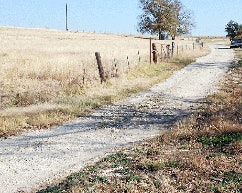 A clogged corrugated drainpipe under this Texas road results in water flowing across it, eroding the surface and creating a ford in wet weather.
A clogged corrugated drainpipe under this Texas road results in water flowing across it, eroding the surface and creating a ford in wet weather.If you don’t drive them often, it’s easy to overlook unpaved roads. After all, they carry significantly less traffic than rigid or flexible pavements in areas where most people don’t live. Typically, unpaved roads carry less than 150 vehicles per day, and those vehicles tend not to put excess stress on the road structure. That is, unless it’s during harvest time, when a limited number of overloaded trucks put very heavy loads on these dirt and gravel surfacings.
Unpaved roads aren’t limited to rural areas. In December 2012 the residents of Ft. Lauderdale’s South Middle River neighborhood – located off the busy Andrews Avenue corridor, just blocks from downtown Fort Lauderdale, Fla. – demonstrated for reconstruction of their dirt streets by removing road construction signage from an adjacent work zone and using it to direct motorists down their dirt street. The demonstration continued for 40 minutes before police broke up the gathering, reported the Ft. Lauderdale SunSentinel.
In recent years, declining road funds, rising traffic and loads have combined with natural calamities like floods to stress the nation’s unpaved roads. Significantly, the boom in fossil fuel extraction of oil, oil sands and natural gas from states from Pennsylvania to Texas to Wyoming, and in Canada’s western provinces, has put new stresses on unpaved roads as they carry construction equipment inbound, and extracted resources outbound. Fortunately this new boom is providing a fresh stream of tax revenue for road repair.
Even the boomlet in windmill-powered electricity generation has stressed unpaved roads. Often, access to agricultural areas where wind farms are located is entirely via unpaved roads, which suffer under heavy traffic from 50,000-pound concrete mixers, and trucks hauling 800-ton cranes.
Unpaved Road Preservation
While preservation of asphalt and concrete pavements has become quite technically advanced, preservation of unpaved gravel, stone or dirt roads is still at the maintenance stage, in which preservation is defined as preventive maintenance.
South Dakota has articulated a checklist for preservation of its many miles of gravel roads. Blading and graveling of mainline roadways and shoulders are effective at reshaping or replacing granular material lost on the surface of either a roadway or shoulder, the SD DOT says.
“Graveling of mainline or shoulders involves shaping of the surface and a periodic addition of granular material to provide a smooth driving surface or shoulder that has a proper crown slope and is free of ruts and distortions,” it maintains. Deficiencies include:
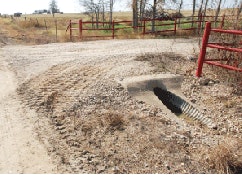 Well-built and maintained culvert keeps water off both unpaved roadways.
Well-built and maintained culvert keeps water off both unpaved roadways.• Rutting and shoving of material. Wheel motion of the traffic will shove material to the outside (as well as in-between traveled lanes), leading to rutting, reduced water-runoff, and eventual road destruction if unchecked, the state says. As long as the process is interrupted early enough, simple blading is sufficient, with material being shaped to correct the deficiencies.
• Washboarding. Washboarding is the formation of corrugations across the surface at right angles to the direction of travel. They can become severe enough to cause vibration in vehicles so that bolts loosen or cracks form in components, the DOT says. Blading performed under the correct moisture conditions will aid in removing the corrugations, and the addition of a good quality gravel can help prevent them reforming.
• Cross slope. The amount of crown in the roadway or shoulder should be maintained at a rate of 0.3 foot per foot, to 0.05 foot per foot. This amount of crown will allow for adequate drainage of surface water without washing off surface materials, South Dakota says.
• Loss of fines. If a gravel-surfaced roadway or shoulder has dust blowing off the surface, it indicates a loss of fines, and material is being lost, causing the road to deteriorate. “Typically a roadway with average traffic loses about 1 inch of material per year,” the state says, “so periodic replacement with good quality material is a necessity.”
• Blading and reshaping of a roadway or shoulder should take place in moist weather conditions if possible, the South Dakota DOT says. “When blading, material should be pulled from the in-slope area back up onto the roadway or shoulder surface and smoothened, watered, and compacted to the proper grade and crown slope. The grader should be operated at a top speed of between 3 to 5 miles per hour, and the grader moldboard should be operated at the correct angle and pitch to adequately move and mix the material.
Inventory, Plan in Washington County
Maintenance of unpaved or gravel roads in a jurisdiction can be addressed in a systematic method, as Washington County, Iowa – located just west of the Quad Cities – did recently.
Beginning in 2008, when a “perfect storm” of diminished cash flow, increasing traffic and loads, and excessive flooding severely damaged many unpaved roads, the county’s engineering staff prepared a $12 million, multi-year unpaved road improvement program funded largely by an $8 million general obligation bond issue that county engineers were able to justify with the plan.
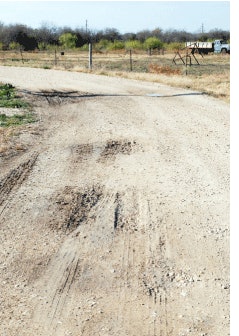 Poor drainage results in ponding and aggregate loss in unpaved roads.
Poor drainage results in ponding and aggregate loss in unpaved roads.“High costs and flat revenues, increased vehicle weights, and increases in rural traffic volumes have created conditions on the gravel road system in Washington County that are quickly becoming unacceptable to residents,” said David Patterson, P.E., Washington County engineer, in September 2008.
“While any one of these changes – financial, increased weight, or traffic issues – could probably be handled by the system under its current allocation of resources, the combination of all three has tipped the system into a downward spiral that will become irreparable if changes are not made,” Patterson said in terms that are familiar to the pavement preservation community. “Under its current allotment of resources, the gravel road system has reached a point where damage is being done faster than can be repaired.”
This plea was buttressed by an unpaved roads inventory. “During the summer of 2008 the Secondary Roads Department performed a complete inventory of the gravel road system in the county,” Patterson said. “The inventory marked the condition, needs, and noted any special circumstances of every gravel road in the county.”
A comprehensive review of the available solutions was then performed to see what solution would best apply to which road. These solutions included adding rock surfacing, grading the roadway to repair deficiencies, upgrading a roadway for paving, or vacating/downgrading the road classification.
As articulated in 2010, Patterson outlined four outcomes for bringing county unpaved roads up to par:
• Fix the six to eight “hot spots” where the county spends three to four times its average maintenance dollar (average of $2,500 per mile, compared to $7,500 to $10,000 per mile in these locations)
• Make system-wide improvements to gravel
• Reduce long-term maintenance cost, and
• Rebuild and recover from disasters like the extensive flooding of May-June 2010, when it rained continuously.
Ultimately the plan would provide five miles of new paving, rebuilding of 80 miles of gravel roads, and additional rock surfacing for 40 miles of roads. “By improving these 125 miles of roadway, maintenance resources will be available to make improvements on the other 800 miles of our county roads,” Patterson said. “The new gravel roads would be 30- to 50-percent cheaper to maintain, trap less drifting snow, have proper drainage, and have an appropriate surface course for the traffic they are carrying.”
GPR and Gravel Roads
The use of motorized vans carrying ground penetrating radar (GPR) is well-established in characterizing the subsurface conditions of road networks as road agencies update their pavement condition inventories, but in 2012 researchers at the University of Illinois at Urbana-Champaign described use of GPR for unpaved roads.
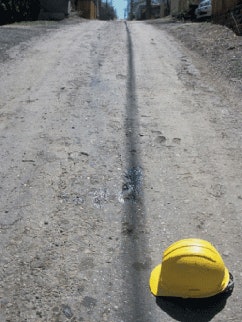 In Denver, this unpaved alley was topped with a mix of straight RAP and neat rejuvenator, and then compacted; the result is an inexpensive unpaved driving surface.
In Denver, this unpaved alley was topped with a mix of straight RAP and neat rejuvenator, and then compacted; the result is an inexpensive unpaved driving surface.In their TRB paper Assessment of Subsurface Deformation in Unsurfaced Pavements Using Ground Penetrating Radar, U of I graduate research assistants Debakanta Mishra and Zhen Leng, and professors Erol Tutumluer and Imad L. Al-Qadi describe the findings of full-scale accelerated pavement testing to evaluate aggregate quality in two unsurfaced pavement sections.
“An innovative application of the nondestructive GPR technology was established for assessing subsurface deformations and distinguishing between the different rut mechanisms that contributed to the failure of unsurfaced pavements,” they write.
They observed that aggregate type and angularity clearly governed the mechanisms responsible for rut accumulation in unsurfaced pavements. “An uncrushed gravel layer with high fines underwent internal rutting through shear flow and exhibited significant heaving adjacent to the wheel path,” they say. “The pavement test section with the crushed aggregate base, on the other hand, showed significantly higher load resistance and primarily exhibited subgrade shear failure at load repetitions much higher than the gravel section.”
GPR scanning of unsurfaced pavement sections shows promise for identifying different rutting modes and assessing subsurface layer deformations and damage potentials, they conclude, adding this concept can be further expanded to quantify the accumulation of rutting in individual layers by estimating the dielectric constants of layer materials.
RAP Stabilizes Unpaved Surfaces
With a boom in natural gas extraction – as well as high production from its low-sulfur coal surface mines – Wyoming unpaved roads are suffering from very heavy truck traffic, as well as an increase in automobiles.
But increased use of reclaimed asphalt pavement (RAP) to preserve riding surfaces is an option that offers a low-cost, but substantial, way to suppress dust loss and enhance aggregate retention, say Burt Andreen and Harry Rocheville, graduate research students at the University of Wyoming, and the university’s Khaled Ksaibati, Ph.D., P.E., in their 2012 TRB paper, A Methodology for Cost/Benefit Analysis of Recycled Asphalt Pavement (RAP) in Various Highway Applications.
In recent years, RAP has been used as a surface additive on Wyoming’s unpaved roads, streets and alleys. This has been boosted by recent state legislation, which compensates Wyoming DOT for RAP donated to Wyoming counties. That being said, the DOT and local agencies needed to evaluate the cost effectiveness of blended RAP and virgin aggregate as a surfacing material for unpaved roads, and that was the goal of the research.
For the test, two half-mile sections were constructed using RAP, which was distributed using bottom discharge dump trucks and then spread with a motor grader. The RAP and existing base were then mixed by a mobile stabilizer using a toothed drum, which mixed the RAP with 6 inches of base and released the mixture back onto the road surface. This mix of RAP and existing base then was sprayed with water and compacted to achieve maximum density.
“RAP in gravel roads resulted in a savings of $17.07 per ton of RAP in this case … due to the savings from virgin aggregate and the savings through dust reduction, which will keep the road in better condition by retaining the fine particles embedded in the road,” the authors write. “The air quality will also be improved as a result of the reduction in dust.”
The City of Denver, Colo., has been using RAP to surface its unpaved alleys, where the RAP particles “knit” to a solid surface in the hot sun. For its unimproved alleys, in the spring and fall, the city removes 6 to 8 inches of surface with a mid-size cold mill, and replaces it with RAP millings. This turns them into a gravel alley and reduces dust and runoff components.
Once, the city would bring in trucks, grader and a backhoe loader to dig the alleys out. Now the cold mill does the excavation work in one pass, cutting the work time from three to one day. Following 8 inches of excavation, the cold millings are brought in, graded and compacted.
In the heat of the sun, the millings meld to form a firm surface that holds up to residential traffic loads, with no truck traffic other than the refuse trucks once a week. Denver also has experimented with mixing cold millings with rejuvenator in the equipment yard, and then placing it in the alley with a paver. The result is a simple cold mix with consolidated surface.
Dust Research in Alaska
Fugitive dust escaping from the surface of unpaved roads has severe negative effects. The dust can affect air quality because it is a PM 10 material, defined as composed of particles 10 micrometers or less. And as dust leaves the surface of a gravel, stone or dirt road, aggregates and other fines loosen, leading to surface problems and costly replacement with new gravel.
Dust palliatives suppress fugitive dust. Spread by distributor truck, they suppress dust on a driving surface, keeping moisture in the road. Some, like liquid calcium chloride, a very common dust palliative, absorb humidity from the ambient air, suppressing dust by keeping it relatively damp. Calcium chloride absorbs water vapor from the air and moisture extant in the road structure. At 77 degrees F and 75 percent humidity – common conditions during summer in the Midwest and South – it absorbs more than twice its weight in water. In addition, calcium chloride solutions attract more moisture to the road than they give up in evaporation. Thus a treated road surface can retain moisture even during the heat of summer.
In early June, a research team from the Alaska DOT&PF Statewide Research, Development, and Technology Transfer program, and the Alaska University Transportation Center, continued remote field work testing dust-reducing palliatives at rural runways and roads across Alaska.
Using a unique portable instrument and a variety of dust-control palliatives, they are helping the state compare which dust treatments are the best for specific unpaved road and runway locations throughout the state.
The instrument, the DUSTM, monitors palliatives on gravel airports and roads in over 30 remote Alaska communities. When deployed, it mounts on the rear of an ATV to measure loftable dust levels (defined by the EPA as PM 10). An air intake extends from the unit off the back of an ATV and pulls a continuous air stream as the ATV drives at specific speeds over a surface. As dust emerges, the air stream is pulled through a tube and passes by a laser, which measures the opacity of the airstream. This data is then recorded in an on-board datalogger box, which can be analyzed later. Early results show various palliatives reduce dust from 65 to 99 percent.
‘Gravel Roads Academy’
An outreach program – the Gravel Roads Academy – teaches how to both provide optimal gravel road conditions for local drivers, and optimize shrinking budgets.
Launched in 2012 by the makers of DustGard – a road stabilization and dust control product – the Gravel Roads Academy trained road engineers and maintenance crews in 16 states to build and maintain gravel roads for greater cost savings, superior stabilization and improved air quality.
Held from March through October, the free Gravel Roads Academy engaged “gravel gurus” to teach city, county and state road professionals the most efficient unpaved road construction and maintenance techniques, including the regular (usually annual) application of a road stabilizer and dust control product.
Each 1 ½-day session included a field demonstration of motor grading techniques and stabilization, and taught best practices in design, maintenance, stabilization, resource management, air quality and funding options. Approximately 35 sessions will be conducted in 2013. For more information, visit www.gravelroadsacademy.com.
When Paved Roads Go Bad
The potential of road agencies letting a paved road deteriorate to unpaved status has achieved notoriety in our age of diminished agency budgets. Whether and how to let a road “unpave” was explored in February 2012 at the 16th Annual TERRA Pavement Conference at the University of Minnesota-St. Paul.
There, Freeborn County, Minn., engineer Sue Miller described the unpaving of County Road 20, which was so far gone that county repair trucks were destroying the surface as they attempted to repair it. Unpave a road with trepidation, she warned, and, as she said “Make sure you don’t take a bad bituminous surfaced road and make it into a terrible gravel road.”
County Road 20 was disintegrating, but was not scheduled for any type of major maintenance until 2015. “We had to unpave it, reclaim the useless broken asphalt, and revert to a gravel-surfaced road until we had time to consider alternatives to traditional paving and find the required funding,” she said, as quoted by Richard Kronick in the Spring 2012 Minnesota LTAP newsletter.
When Miller used the word “unpave” in a county board meeting, she discovered that it was loaded with negative connotations, Kronick writes. “For some of my county commissioners, the word unpave means loss of service. It means we’ve failed. No one wants to tell constituents that the level of service they expect can’t be delivered. In fact, I was told not ever to use that word again!”
The dean of gravel road maintenance, South Dakota Local Technical Assistance Program’s Ken Skorseth, said removing asphalt and reverting to a gravel surface may only lead to different types of problems, Kronick reported. “If the truck traffic is 25 to 50 ADT and there is low subgrade support, you will need 14.5 inches of gravel,” Skorseth said. “That’s hard to do when trucks are knocking it off constantly and the blade needs to be out there every other day. Furthermore, the quality and availability of gravel varies greatly from place to place.”
Unpaving, or reversion of a paved road to gravel, is not widespread. The most current overview will be found in the June 2010 research synthesis, Decision Tree for Unpaving Roads. Download the report – which includes state and local agency experience – at www.lrrb.org/media/reports/trs1007.pdf.





